4 Best Lures For Steelhead: A Pro Guides Recommendations
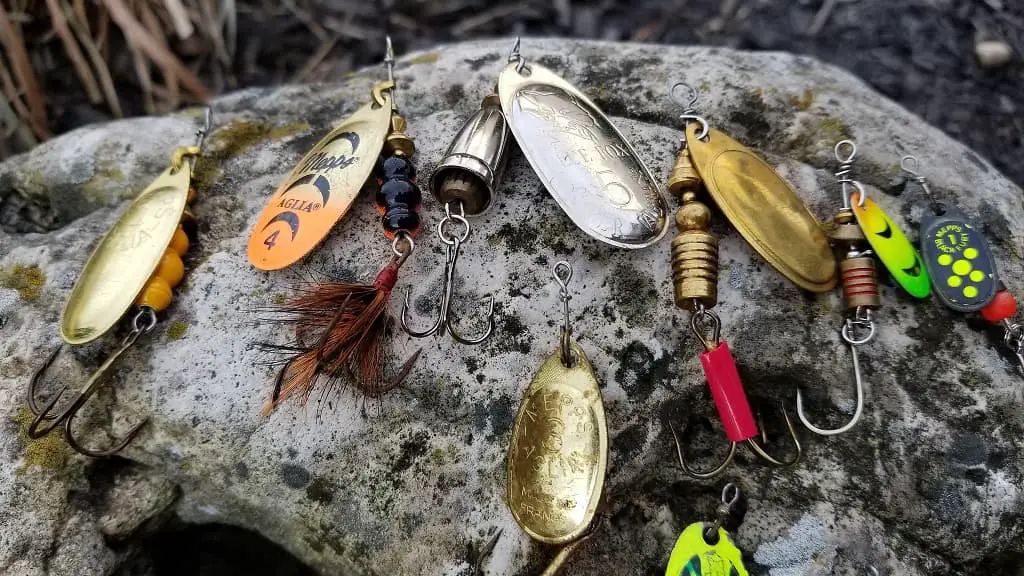
Wouldn’t it be great if you knew what the best lures for steelhead were and what the steelhead river guides use? As a river guide, I have had the opportunity to test many lures and can confidently tell you what the four best types of lures for steelhead are for different types of water and in different river conditions.
The most effective steelhead lures are:
- Spinners: Size #3, in multiple colors. My favorite is the Vibrax Spinner
- Spoons: Heavy 3-inch casting spoons, with a straight retrieve or jig-type retrieve is best. Many colors work.
- Plugs: Slow moving, and with a great wobble or action. Some of the best are Kwickfish and Yakima Mag-lips
- Crankbaits: Brads wiggler, Rapalas, and Storm crankbait in 3 to 5-inch lengths are the best.
These steelhead lures will account for over 90% of the steelhead caught by lure anglers on steelhead rivers around the Great Lakes and the West Coast.
I will also add two bonus lures that you may not have thought about yet. Plus, since I’m a fishing guide and have a ton of knowledge on fishing steelhead with lures, I will add some tips and tricks to make your lures more effective.
We may make a small commission from some of the links on this website, which is at no cost to you. I appreciate your support.
Best Lures For Steelhead Fishing
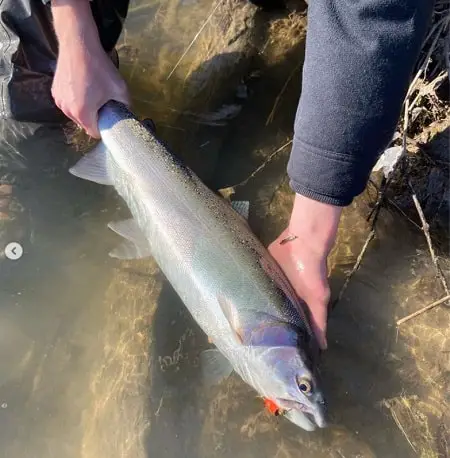
The honest truth is that many anglers don’t fish lures as effectively as they could, so even if they are using good lures, they will still struggle to consistently catch fish.
Part of the reason is that they don’t know how to work the lure, give it action, at what depth to fish the lure, and even how to cover the water effectively. Getting any one of these things wrong can mean fewer or no steelhead, imagine getting most of them wrong!
I’ll provide some advice on these things so you can better understand how to fish your lures more effectively.
Somedays, the steelhead and trout are not very aggressive; when this happens, not all lures will work. Some lures will trigger more bites than others, therefore it’s good to have a few different lures or all of these lures in your box, and to try them all.
The Spinner Is The Best Steelhead Lure
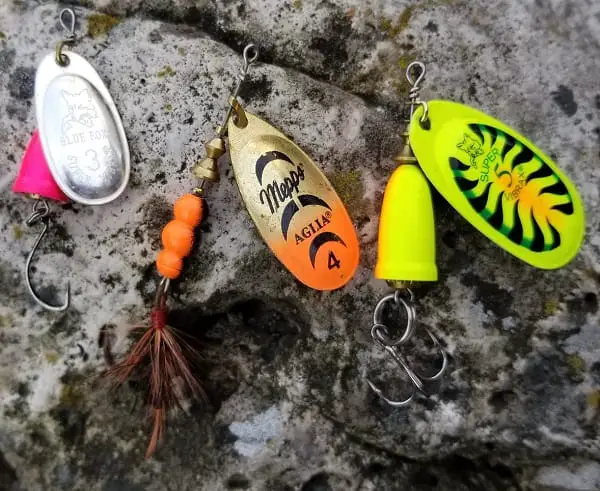
On many guide trips, the first lure I will try is the simple but time-tested spinner, which is also known to some as an in-line spinner.
I consider spinners to be one of the most effective lures in rivers.
The spinner is one of the best steelhead lures to use because it can move fast and cover a lot of water quickly, making it a great search-type lure.
If this lure is fished well, it can be the best steelhead lure on both the Great Lakes steelhead rivers and the West Coast steelhead rivers.
The key to fishing this lure well is to let the current do most of the work for you and to get the spinner down to within 2 or 3 feet of the steelhead. There is one other thing that I do to entice more strikes.
How To Use A Spinner For Steelhead?
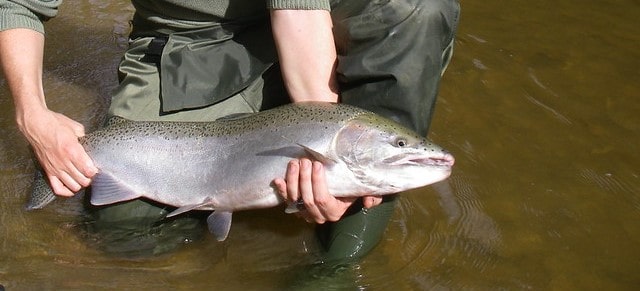
In order to use a spinner well and get the best results, I cast the spinner across the river and on a slightly downriver angle and then retrieve it at less than half the speed that I think I should.
Basically, it’s a super slow retrieve that almost feels way too slow, but it works. At the beginning of the retrieve, I will give the spinner a fast but short pull to ensure the blades start spinning, and then I slowly work the spinner in.
Even though it’s a super slow retrieve, the current will spin those blades for you and will swing it across and in front of the fish at a slow and enticing speed.
Both aggressive and less aggressive steelhead may strike out at a slow-moving spinner, whereas a fast spinner may only get the most aggressive fish to feed, which may mean fewer fish for you at the end of the day.
The exception to this is that if you feel like the fish are very aggressive and will hit the faster retrieve, it may be better to use a faster retrieve because you can make more casts, cover more water, and therefore catch more fish.
Keep in mind that a retrieve on a downriver angle that is reeled in too fast will stay high in the water and might be way over their heads, and a retrieve that is too slow will hit too much bottom.
If a faster retrieve is what you want to do, you may need to keep the tip of the rod below the water, and it will help keep your spinner deeper. It also helps to use a spinner that gets down deeper. See my favorites below.
For a normal to slow retrieve, I recommend that my clients set the drag perfectly and keep the rod two feet off the water for a better hook set and to keep the lure down deep. Point the rod tip straight at the spinner but don’t pull it, let the current swing it across the pool for you.
If you start hitting the bottom, maintain the same speed but lift the rod tip higher to try to keep the lure 2 to 3 feet off the bottom. You may need to keep going higher and higher to prevent hooking too much bottom.
GUIDE TIP: One thing I sometimes do to entice more strikes is to rip or jerk the spinners every 6 to 10 feet. I will often make the first retrieve a straight-in retrieve and then run the exact same path a second time with a more erratic and jerking and ripping type retrieve to see if that will trigger a strike. Some days, they will really react to this jerking type of retrieve.
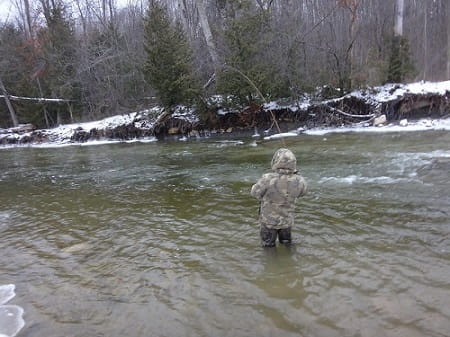
The biggest mistake I see anglers make is not covering the water very well.
They aimlessly cast all over the place when they should be fan casting and covering the water systematically and covering every foot of the spot they are fishing.
The difference between an angler covering the entire spot systematically compared to an angler casting aimlessly is sometimes 10 to 1.
The other mistake I see all the time is when anglers cast up the river and then reel downriver. When you do this in faster water it often means you have to reel extra fast just to get those blades spinning and just to keep the lure off the bottom.
That extra fast lure coming straight at the fish means that it might be too fast and the fish will miss it or not hit it at all. Casting up the river is not a good angle.
What Size Spinners Are Best For Steelhead?
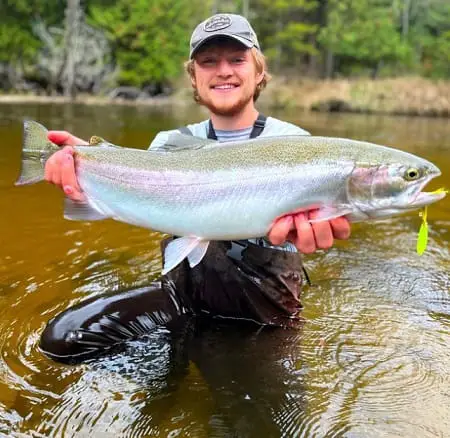
The best spinner size for steelhead are sizes 3 and 4 spinners for most river conditions, and will start with a size three first and then work up to a size 4 or even size 5 to see what the steelhead wants. If the steelhead hits a size 3 or 4 right off the bat, I will just leave it on and fish it hard.
Under dirtier water conditions, I will often go to the bigger spinner first, which could be up to a size 5, and under low and clear water conditions, I will sometimes start with a size 2 spinner and work up to a size 3 or 4.
What Is The Best Spinner Colors For Steelhead
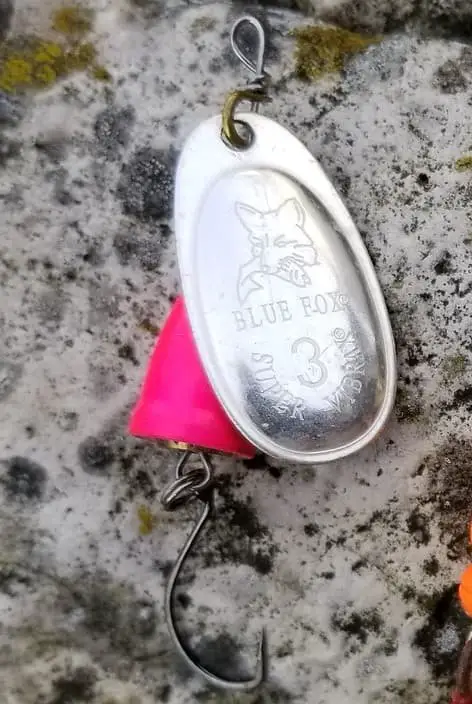
The best color for steelhead spinners color on clear or slightly greenish-colored water is a silver blade spinner that has a silver body or colored body. See picture.
If the steelhead doesn’t eat the silver color, I will start to rotate through colors, trying to find out which color they want.
After the silver color, I will try a gold blade spinner next, and if that doesn’t seem to work, I will go to chartreuse, pink, black, and orange blades to try to determine what it is that they want.
If the water is dirty I will go straight to chartreuse or a black spinner in a size 5.
In dirty water, I prefer spinners that make a lot of noise, like the Blue Fox Vibrax Spinner, because even if they can’t see the spinner in the dirty water, they may be able to home in on it by the vibration.
For nighttime lure fishing, I also prefer very loud spinners, and my best color is usually black. The black silhouette seems to stand out and is easy for them to find.
Single Hook Or Treble Hook Spinners For Steelhead
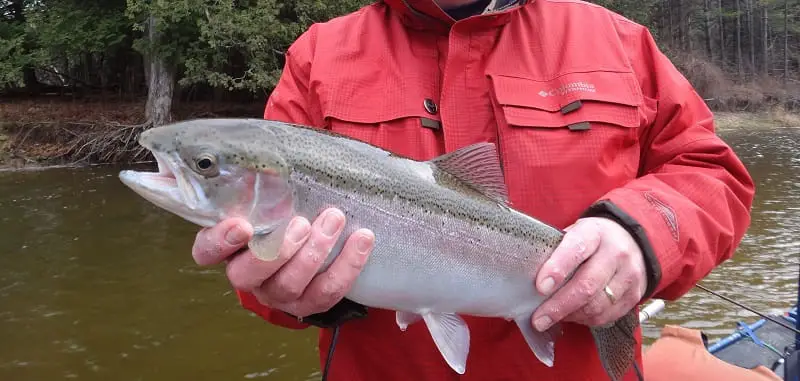
I tend to use a single hook on my spinners most of the time for a few good reasons.
First, I like to get my spinner down to the fish, and I find that the single hook doesn’t hook up on the bottom as much as a treble hook does, and therefore I don’t lose as many lures.
A large single hook seems to hook as many fish as a treble hook due to the larger gape, but the single hook doesn’t do as much damage to a fish that you plan on releasing. Treble hooks can also be a nightmare when they get tangled in the net, but the single hooks are not so bad because the hook is usually in the fish’s mouth.
Prevent Line Twist With Spinners
Adding a quality size 3 or 4 snap swivel like the ones from Owner Brand or a size 4 Spro Snap Swivels may prevent unwanted line twist that is common with spinner fishing, and the swivels make it easier for you to change colors and sizes.
The Best Spinners For Steelhead – My Favorite

The best spinner for steelhead is the Blue Fox Classic Vibrax Spinner or the Super Vibrax Spinner.
I’ve seen fish move over a long way to hit a Vibrax spinner, and I truly believe that a Vibrax spinner makes so much noise that some fish will feel the vibrations long before they even see the lure.
I also like that Vibrax spinners come in a fast deep water model and a normal or slower water model and that they have a tone of great colors to choose from.
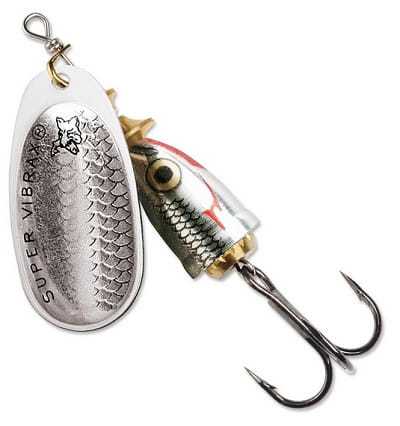
Best All-Around
This is the spinner I use the most and under most river conditions. It can be retrieved fast or slow and shallow or semi-deep. I also use the tailed version, which is the Super Vibrax Spinner. The tail provides more movement and is a bigger profile.
Check Prices
Also, check prices and colors at Bass Pro Shop and Amazon.
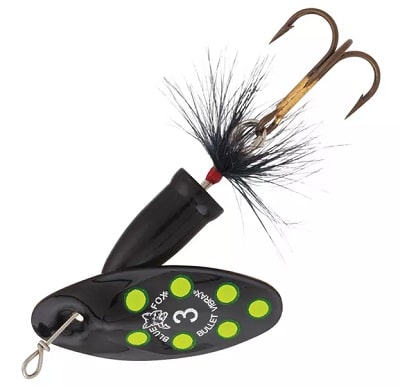
Deep and Fast
The Blue Fox Vibrax Bullet Spinner is one of the best spinners that I use for deep and faster water. The thinner blade helps it get deeper than other spinners. It also moves faster with less drag and is great for searching and covering more water.
Check Prices
Also, check prices and colors at Amazon.
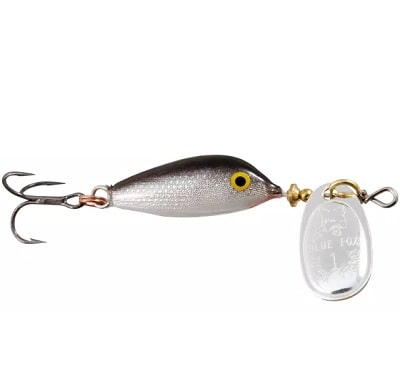
Larger Profile
Blue Fox Vibrax Minnow Spin lure looks like a minnow bait but with the added flash of the spinner. This can be effective, and it offers trout, steelhead, and salmon a larger profile, which can also be a good thing. I have done my best with the rainbow, brown, and silver colors.
Check Prices
Also, check prices and colors at Bass Pro Shop and Amazon.
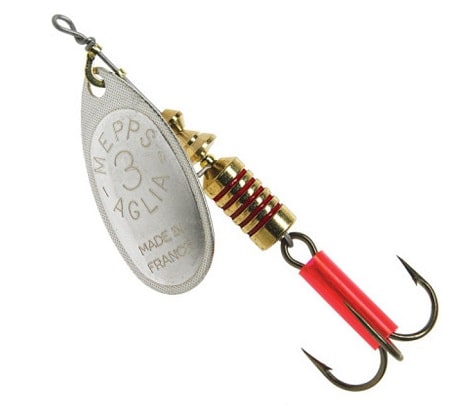
Another lure I have been using for the last few years with very good results is the Regular Mepps Aglia, the Mepps Aglia Dressed, and the Mepps AgliaI Flashabou. I believe the flashabou tail really gets the attention of the steelhead with the flash and movement.
I highly recommend the Mepps Flashabou spinner in size 3 or 4 in the Silver Blue-silver, Silver black- silver, brown trout, and gold brown-orange. Chartreuse blade and Orange blade in size 5 are my -go-to in higher or dirtier water.
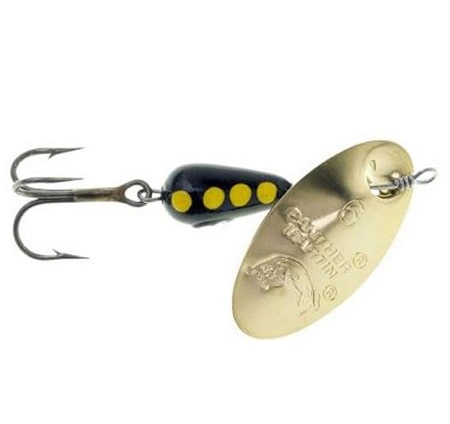
I have also had good results with Mepps Black Fury and Panther Martin spinners.
Panther Martins were the best sellers for trout and steelhead in my tackle store and my store customers swore by them.
I do well with the Panther Martin Regular or the Panther Martin Hammered series.
There are other good spinners that will work, but honestly, these three brands have you covered with sizes, colors, and styles, so these are all you need.
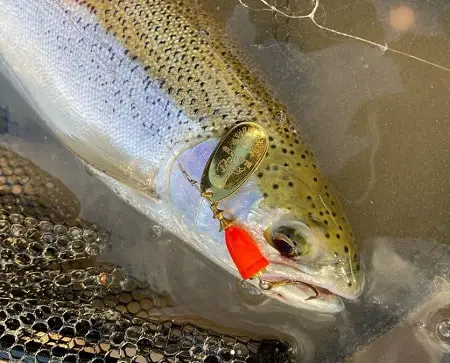
Check out Spinner Fishing for Steelhead page for in-depth information on how to effectively cover the water, get the right depth, and my most effective presentation methods for spinners.
The KwikFish Is One Of The Best Steelhead Lures
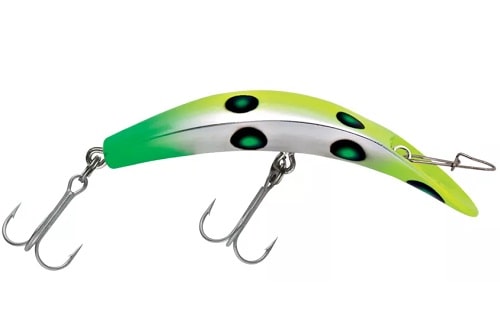
The Kwikfish lure has been one of my most productive, and steelhead lures in all kinds of water conditions and is still my favorite steelhead lure in cold water.
The Kwikfish lure has been around for a long time, and it’s still one of the best steelhead lures for Great Lakes and West Coast steelhead.
You may also find some different colors to try in the Flatfish but both lures are great.
How To Fish A Kwikfish For Steelhead
What makes this lure so good is the action it has and the ability to move it slowly through the water. This lure has a crazy back and forth wide wobble that drives fish crazy. Both aggressive and neutral fish will smash this lure when it’s wobbling in their face.
I fish this lure similar to the way I fish spinners with an across and slightly downriver angle and with a super slow retrieve as it swings across the pool. Working the lure deep and moving it 3 feet down each time I cast will cover the water well.
If I hit bottom, I simply lift my tip up a couple of feet to keep it just over their heads. If I hit bottom again, I lift the rod tip even higher.
Be careful not to reel this lure too fast as it tends to run sideways and will come up to the surface if you do. Keep it low and keep it slow!
If one color doesn’t work, start rotating through colors until you find a color that works for you.
The Best Kwikfish Colors For Steelhead?
This lure comes in a bunch of great colors and color combinations, and I have a few favorites that work really well for me.
For low and clear water conditions, I will use more natural colors like the Rainbow Trout, or the MJ-Black-Holo Glitter pattern which is my best color even in bigger water. Silvers and golds can sometimes be good in lower clear water too since these colors can resemble bait fish or small trout and salmon. Just make sure you use the right sizes.
For dirty water, I like to go with a larger 4 to 5-inch size in chartreuse, and silver, or a combination of silver and bright fluorescent colors.
I also really like the Luhr Jensen Kwikfish K Series with the Rattle in dirty water because I believe the fish will pick up on the sound before they see the lure and this will get you more bites.
For most normal medium to large size rivers with clear to greenish water, I do really well with the colors MJ-Black-Holo Glitter, Slammer, Silver Pink Mamba, and Black Chrome Red Streak, but there are a lot of other colors that work.
I tend to rotate through all my colors and sizes until I find out what they want.
Just like with all lures, the key to success is to cover the spot well with each color. To do this effectively, it’s not uncommon for me to work one color like silver through the entire spot, moving down 2 to 3 feet with each cast and work all the way to the bottom of the pool and then move back up to the top of the pool and do it again with an opposite or contrasting color.
This means if I started with a shiny color like silver, my second color I might go straight to a black or very dark color, and if that doesn’t work, maybe switch to something very bright and weird like chartreuse or orange.
The Kwikfish is also one of the most popular lures used when back trolling for steelhead and when back bouncing for steelhead.
The Best Kwikfish Sizes For Steelhead?
For smaller rivers, I will stick with the 2 3/4 inch Kwikfish which is usually big enough for small and larger steelhead.
In the medium to larger-sized rivers or when the water is really clear, I will still catch a lot of fish on the 2 3/4 size and that is the size that I will often start with, in fact, it’s usually my go-to size most of the time but there are times when a larger size is better.
There are times when the steelhead will be more aggressive and attack a larger sized lure, or there are times when I need to get a bit deeper so I will start to increase the size to 3 3/8, and even up to 4 1/4 inches. These bigger sizes are also better in dirtier water.
I make sure I always have an assortment of colors in the 2 3/4 and 3 3/8 sizes.
There are a couple of different models of the Kwikfish and I like the Kwikfish X-Treme the most. I have checked Amazon and Bass Pro Shops and the best prices and best assortment of colors and sizes that I have found for this lure and many lures on this page are at FishUSA.com.
The Flatfish and the Yakima Mag Lip are two very similar lures with similar shape and action to the Kwikfish. I use these two lures the same way and In the same type of water as the Kwikfish. I also know some river steelhead guides both out west and around the great lakes region that prefers these over Kwikfish.
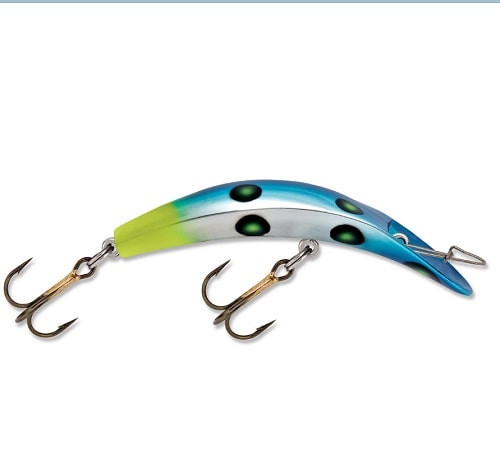
Kwikfish
My favorite plug for river fishing in slow to medium speed currents.
This plug is best casted across and allowed to swing across the pool with an extremely slow retrieve or no reeling at all.
The current will give this plenty of action.
Best Colors:
- Black-Holo Glitter
- Blazing Green UV
- Bubba
- Blazing Red UV
- Fickle Pickle
- Gold
- Silver
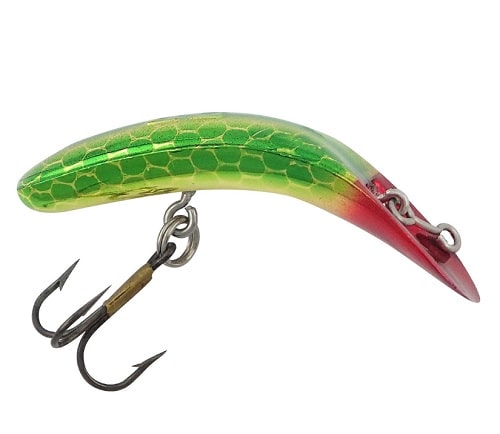
FlatFish
The Flatfish is almost identical to the Kwikfish and works fished the same way and in all the same colors.
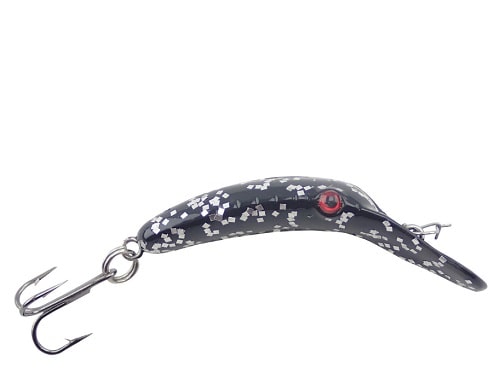
Yakima Bait Mag Lip
The Mag Lip is known as a trolling lure but this lure works well in slower current rivers with a very slow retrieve.
Often, just casting it across and letting it just swing across the river is the best way to use it.
Best Colors:
- Balck Silver Flake
- Keeper
- Bleeding Fire Tiger
- Canada Craw
- Metallic Siver Orange Pirate
There are many more great colors to choose from
Spoons Are One Of The Best Steelhead Lures

I had the opportunity to fish with a client who wanted to fish steelhead with spoons, and I think I learned more than he did that day. I put him in the right spots, and he went to work catching steelhead after steelhead using his technique, which was different from what I normally do.
I realized then that if you fish spoons properly, spoons can be deadly on steelhead in rivers.
Making sure you have the right sizes, the right weights, and the right colors will make a big difference.
How Do You Fish Spoons For Steelhead?
Just like the Spinners and the Kwikfish, slow and low is how you want to fish a spoon in moving water.
The way I fish steelhead spoons now is to cast it across and slightly upriver and then let the spoon drift freely for about 5 to 10 feet to get it down. The slower and shallower the water the less I let it sink. Heavier spoons also sink faster than light spoons, so you will need to adjust accordingly. Once the spoon is just a little bit downriver from me, I will lower my rod tip and start a super slow retrieve.
You should feel the spoon wobbling as you retrieve it and if you hit bottom just lift your rod tip up a little to keep it from hitting the bottom again and to keep the spoon 1 to 3 feet off the bottom.
Move down and repeat those steps. If a steelhead hits the spoon it will be hard and fast so you won’t have problems detecting a strike.
If the water is shallower I will cast my spoons across and down the river and start my retrieve much sooner so it won’t sink so deep. I will also use a lighter spoon in shallower slower water and a heavier spoon in deeper faster water.
When using spoons like the Krocodile spoon below I will sometimes jig or jump the spoon across the bottom. This involves letting it sink longer and then retrieving it very slowly and once I hit the bottom I will lift the tip of my rod a few feet and slowly reel until it hits the bottom again and then I lift the tip of the rod and repeat. This has been an amazing tactic for me for lots of fish.
Adding a quality size 3 or 4 snap swivel like the ones from Owner or a size 4 Spro Snap Swivels may give your spoons more action and make it easier for you to change colors and sizes.
Best Spoon Color For Steelhead
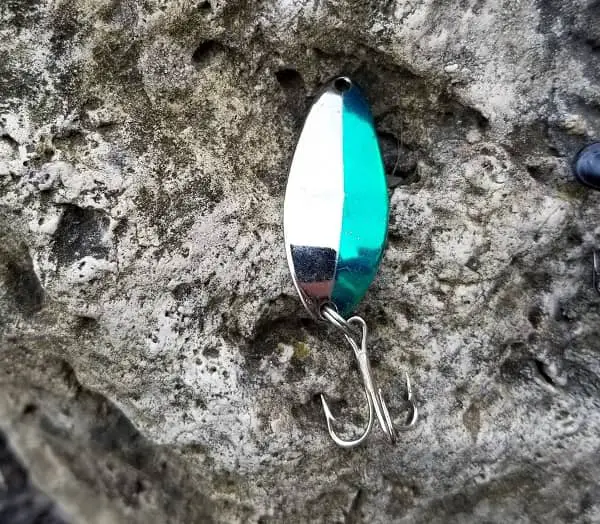
The best color spoons for steelhead fishing in rivers are usually silver and silver with a color combination. Fishing with silver is often the most effective color in most river conditions because the silver flash and wobble of a spoon can resemble the baitfish that the steelhead sees out in the lake or ocean.
I also use combinations of silver with green and blue. In dirty water, I will use bright colors like chartreuse and hot orange or pink. Every river is different, so don’t be afraid to try out golds and reds as well.
Some spoons even come in a glow-in-the-dark finish, and they can be really good for day and night fishing.
Best Spoon Size For Steelhead
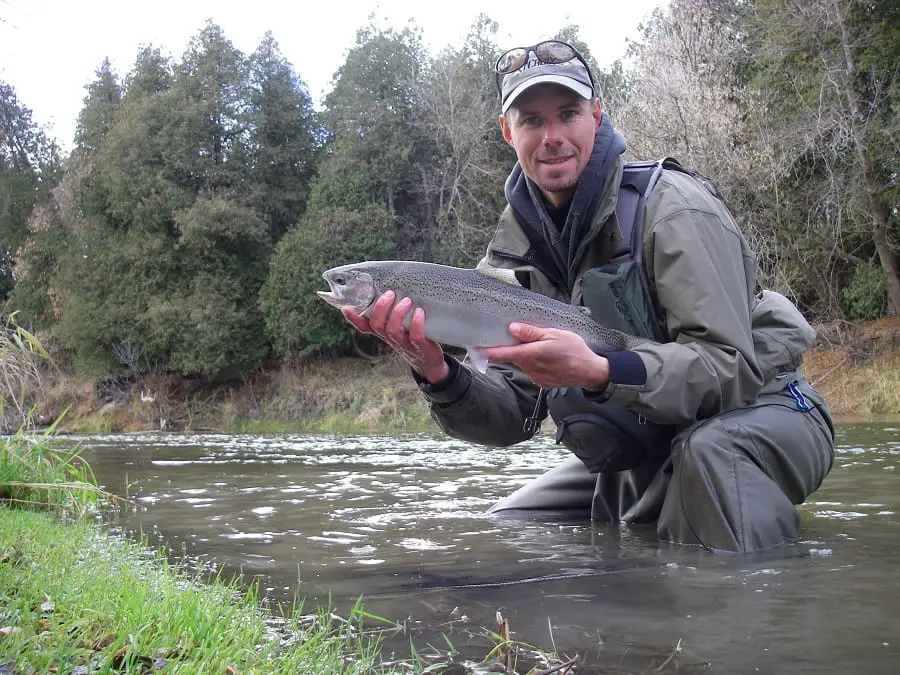
I prefer spoons in the 2-inch to 3-inch size for most river sizes and flows.
For bigger rivers like the Niagara, where there are lots of baitfish for the steelhead to feed on, I may go up to 4 or 5 inches.
Some spoons are also very heavy, so if the river you fish or the area you want to fish is smaller, shallower, and slower, you may want to consider a spoon that is still in that 2 to 3-inch length but isn’t so heavy. The 1/4 oz Krocodile spoon is 2 1/8 inches and is a good choice for this type of water.
Most of the spoons I use for medium to larger rivers are in the 1/2 oz. to 3/4 oz.
Spoons that are too heavy will end up snagging on the bottom too much, and I find lighter spoons wobble better in the current.
Guide Tip – Replace the hooks with a large single wide gap hook so you don’t snag up and lose as many spoons to the bottom.
The Best Steelhead Spoons
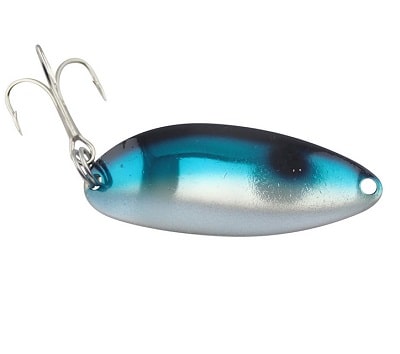
Little Cleo
This is a heavy spoon that is good for faster and deeper water. I prefer the 2/5 oz, 3/4 oz., and 1.25oz.
It’s also one of the best spoons for steelhead, salmon, and trout, when casting into the lake from the shoreline or the pier.
My Best Colors:
- Green Anchovy
- Blue Anchovy
- Green Splatter
- Blue Digger
- Hammered Nickle
- Hammered Nickle Green
- Hammered Nickle Blue
Check Prices
Also, check prices and colors at Bass Pro Shops and Amazon.
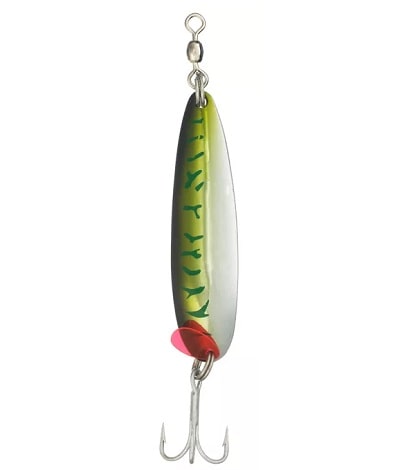
Krocodile Spoon
The Krocodile Spoon is one of the best spoons for steelhead and salmon because it flutters well both on the lift and on the drop. I have used this spoon mostly with sizes 1/2 oz. and 3/4oz.
My Best Colors
- Chrome-Silver Prism Lite
- Rainbow Trout
- Chrome
- Hammered Chrome Neon Blue
- Green Prism Lite
- Chrome Green Mackerel
Check Prices
Also, check prices and colors at Amazon.
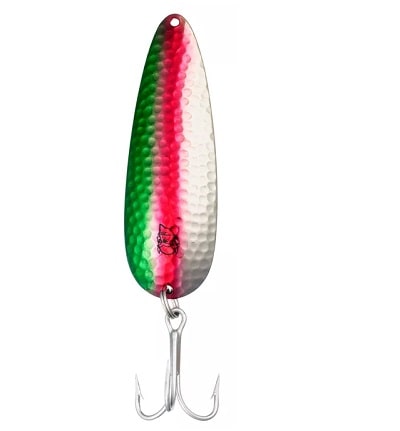
Eppinger Original Dardevle
A good spoon for all river conditions. I use the 2.5 oz / 2 1/4 inch size.
This is also a good steelhead and salmon spoon when casting from the pier or shoreline of the lake.
My Best Colors
- Scale Chartreuse/Black Stripe
- Nickle
- Gold
- Hammered Nickel-Green
- Hammered Nickel-Blue
- Shad (Alewife)
Check Prices
Also, check prices and colors at Bass Pro Shops.
Check out my article, Spoon Fishing For Steelhead for in-depth information on how to effectively cover the water, get the right depth, and my most effective presentation methods for spoon fishing.
Hardbaits For More Steelhead – The Steelheaders Secret Weapon
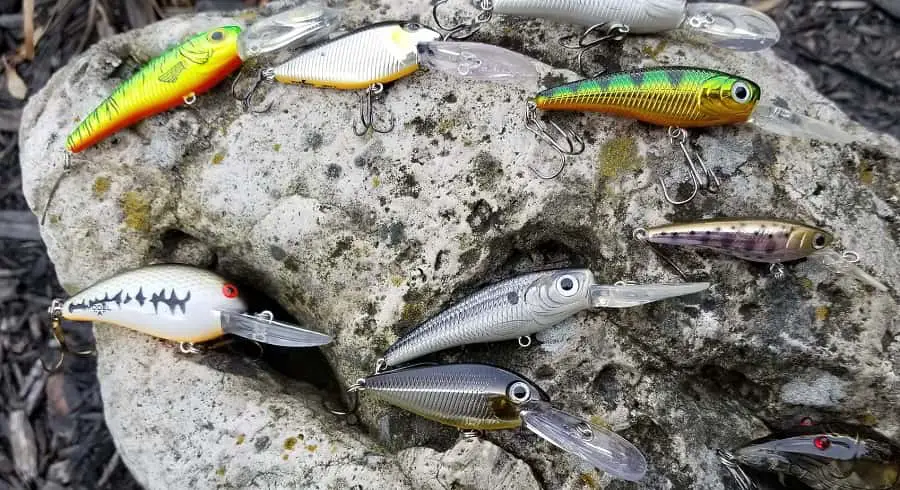
I started fishing for steelhead with crankbaits over 35 years ago. As a teenage kid, I liked watching as the steelhead would shoot across the pool and smash the lure.
Today, I still think that the crankbait is one of the most effective steelhead lures that you can use and is a must-have in any angler’s tackle box.
I use crankbaits in a few different styles for different conditions. I use the fat-style baits with a deep diving lip in medium to deep water at slow to medium speeds.
I like long-profile crankbaits with shallower diving lips for faster, shallower water.
I tend to use a medium to deep diving crankbait most often because I can control my depth by lifting or lowering my rod tip.
Fishing Crankbaits For Steelhead.
Since crankbaits don’t require time to sink, I simply cast them straight across the river or slightly down the river and then slowly retrieve them and let them swing across the river. I prefer a slow, steady retrieve that allows the crankbait to wobble a lot.
A little trick I learned a long time ago was to twitch or rip the crankbait about every 10 feet to trigger a strike.
If you start bumping the bottom, just lift your rod up higher to try to keep the crankbait 1 to 3 feet off the bottom. If you hit bottom too much, you should switch your crankbait to a shallower diving bait.
Guide Tip – The biggest mistake most anglers make is not getting the crankbait down far enough on rivers where you can’t see the bottom. This is why I like deep diving crankbaits, I reel them in with a low rod tip until I hit bottom, and then I lift the rod tip 2 to 6 feet, which should bring the crankbait up and off the bottom.
Just like the other lures that I mentioned above, it’s important to cover the water well and not miss an inch. I tend to cast, retrieve, and then step down 2 to 3 feet and cast again in the same direction, and then repeat.
Each time I step down another two to three feet, my lure should also move downriver 2 to 3 feet which allows me to cover the water 2 to 3 feet at a time which gets my lure in front of all the steelhead. I think under most river conditions, a steelhead will move 3 to 5 feet to hit a well-presented lure.
I almost always tie my line directly to my crankbaits with no snap swivels but you can use a snap swivel.
Best Crankbait Size For Steelhead
The best size crankbait for steelhead is between 2.5 inches and 4 inches with most of my crankbaits being around 3.5 inches. Crankbaits in the 3.5-inch size is what I would consider a perfect bite-size for most average-sized steelhead and in most rivers between 20 and 100 feet.
The Best CrankBait Colors For Steelhead
Crankbaits are used for many species and that means there are tons of great colors to choose from.
Like many of my lures, I like my crankbaits in colors that match the natural forage, like minnows, small trout, steelhead, chub, or suckers.
Silver and black, silver and blue, silver and green are always good choices, but I have had great success with crankbaits in bright colors like orange and chartreuse. Good options for crankbaits even include old favorites like the Rapala Original and Rapala Original Jointed.
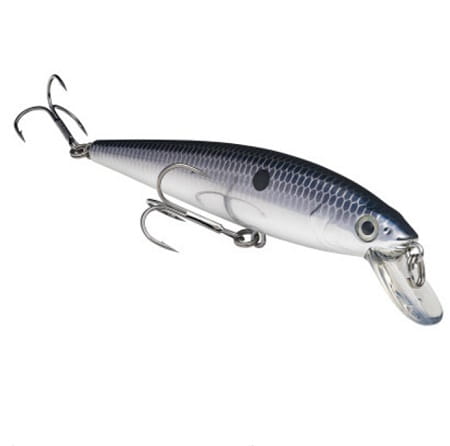
Strike King KVD 200 Jerkbait
A good crankbait that runs 4 to 7 feet and is in that perfect 4-inch length.
My Best Colors:
- Carolina Chrome
- Clown
- Chartreuse Sexy Shad
- Blue Digger
- Sugar Daddy
- Sexy Blue Back Herring
- Pro Gold
Check Prices
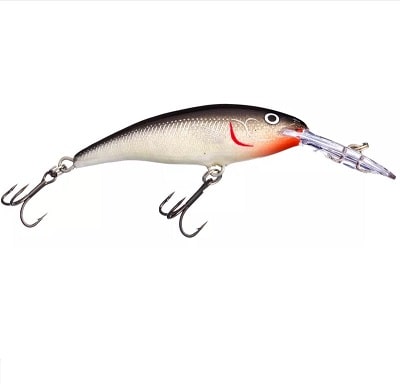
Rapala Tail Dancer
Get deeper with this Rapala that runs 9 to 15 feet. I like the 2 3/4 and the 3.5-inch sizes.
My Best Colors
- Silver
- Shad
- Perch
- Hot Chub
- Blue
Check Prices
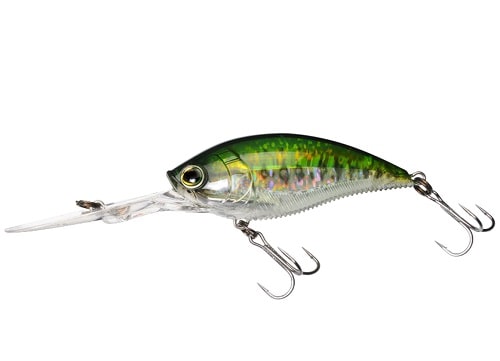
Yo-Zuri 3DB Deep Crank Floating Diver Lure
A short fat model crankbait from Yo-Zuri that runs 4 to 8 feet.
My Best Colors
- Natural Blue Gill
- Gizzard Shad
- Green Shad
- Prism Chartreuse Perch
- Sexy Shad
- Blue Back Chartreuse
Check Prices
Check out Crankbait Fishing For Steelhead page for in-depth information on how to effectively cover the water, get the right depth, and my most effective presentation methods for crankbaits.
Jigs For Steelhead Fishing
There are a lot of effective ways to fish steelhead, and a method that has become a favorite of mine, especially when other methods are not working is jig fishing for steelhead. Click the link for in-depth information, and my favorite steelhead jigs.
Jigs are a type of lure and they are my bonus lure for steelhead. Jigs are not used often by many anglers but jigs have caught me thousands of steelhead, and jigs can work when other lures don’t.
During times when steelhead or not very active due to cold water temperatures or other reasons, jigs get down and close to steelhead and can be used slowly and in an enticing manner, which can trigger bites from steelhead that are not in the mood to chase faster moving lures.
There are many ways to fish with jigs, but I only use jigs two methods that I have found to be most effective.
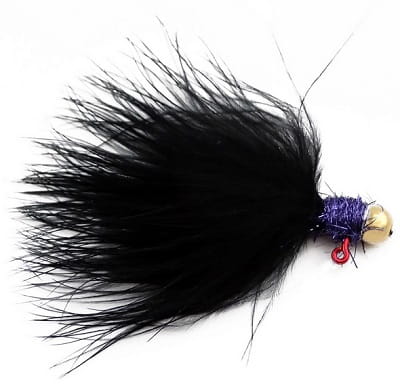
I drift some jigs under a float, or I cast and jig them across the bottom, also known as twitching jigs.
For jigs drifted under a float, I really like these:
- Jiggy Bugger Steelhead Jigs: My most used steelhead jig for under a float.
- VooDoo Custom Tackle Marabou Jig
- Hawken Woolly Bugger Jig.
Both methods can work anytime, but you need to know how to use them, which ones work for float fishing, and which ones work for casting and jigging.
Best Twitching Jigs
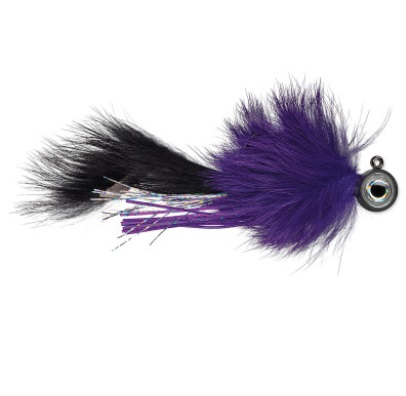
VMC Twitching Jig
There is a lot to like about this twitching jig which is why it’s my favorite.
- Big Eyes
- Sharp wide gap hook
- Rabbit hair and rabbit strip for body thickness, length, and life-like movement.
- Tinsel fibers, flashabou, and living silicone accents
- Lots of great colors
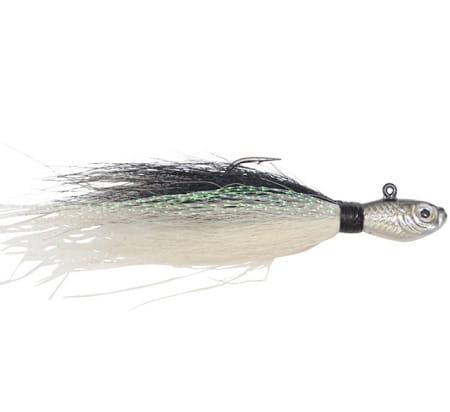
SPRO Bucktail Jig
Another great jig that is one of my favorite twitching jigs for both river and shore.
- made from bucktail for action, body, and length
- Sharp hook with a decent gap
- Lots of great colors and sizes
- Added flash
- Swim head and eye for unique swim action.
- Durable
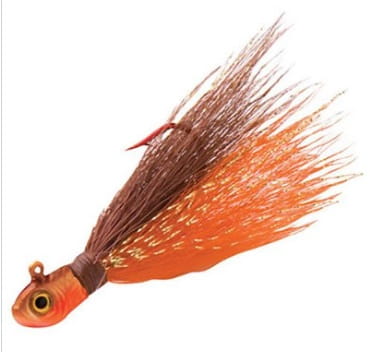
Northland Buck-A-Roo Jig
A twitching jig that is good for steelhead, trout, and salmon fishing.
- Mustad Ultra-Point hooks
- Good thickness and length
- Bucktail with flash for added attraction
- Lots of colors and sizes to choose from
- Large swim head with eyes
- Tip it with a twister tail or paddle tail
Spin & Glow
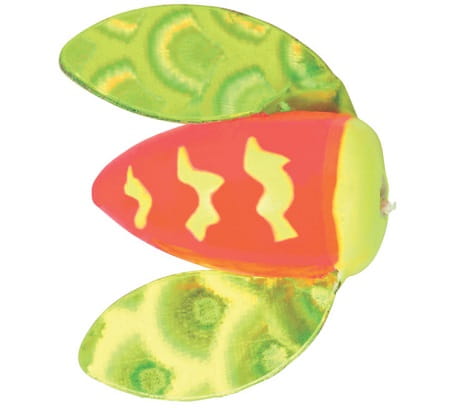
Spin-N-Glo baits are used by anglers and many fishing guides, especially on larger rivers.
The Spin-N-Glow lures can be used by both bank anglers and boat anglers in the river.
They attract the attention of steelhead, and can be especially in winter since some of the methods are a very slow presentation.
The Spin-N-Glo can spin in very little water currents. Using these baits can attract the attention of many fish since they can reach areas anglers find it difficult to reach with other lures or with bait.
Spin-N-Glos are often cast out directly downriver from the steelhead and slowly dropped downriver and allowed to drift towards the feeding areas of steelhead and attract their attention.
When fishing smaller rivers, especially in tight and narrow quarters, anglers can use Spin-N-Glo to attract steelhead’s attention even when they hide behind boulders or logs by dropping the bait down beside and behind the rocks where steelhead might be holding.
Spin-N-Glo is designed to attract attention through color and their spinning abilities. You can be more creative by adding some salmon eggs to the Spin-N-Glo to attract the attention of steelhead easily.
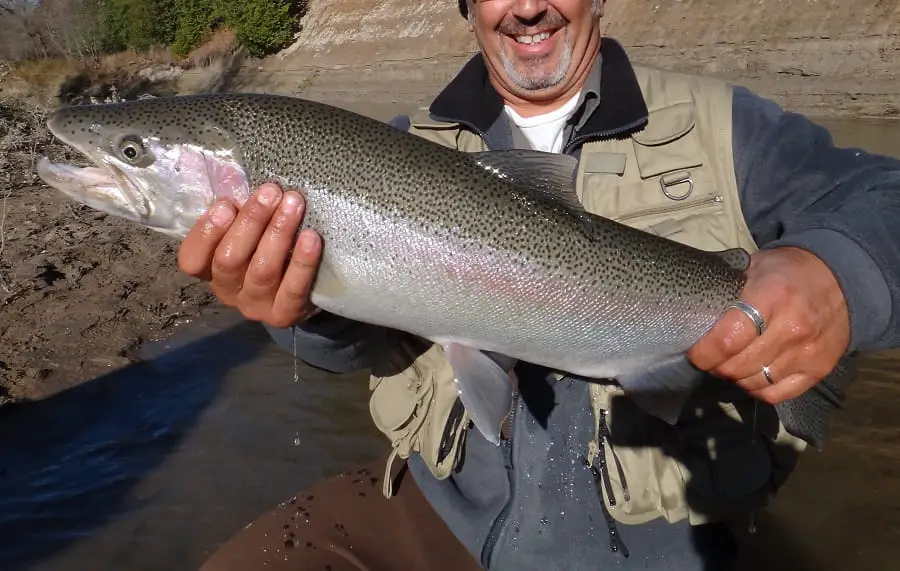
The Right Gear For Using Lures For Steelhead
It’s as important to use the right rods, reels, and lines for steelhead as it is to use the lures that are effective for steelhead.
You want a reel that has a nice smooth drag, holds plenty of line for those long runs and casts well, and can also be used for float fishing.
For the best reels that I have used and that I recommend to my clients, I have a dedicated page on the best spinning reels for steelhead that is worth checking out.
The steelhead rod you should be using should have enough length to manage and play a big steelhead and also enable you to lift the tip of the rod high enough to keep your lures off the bottom. I like rods around 9 feet for lure fishing for steelhead.
A 9-foot rod is also good for float fishing or bottom bouncing in case the steelhead are not in the mood to chase steelhead. Check out the page on the Best Steelhead Spinning rods that I use and recommend.
The right line can make all the difference so make sure you have a line on that is strong enough to handle big steelhead, durable enough to take a beating on the rocks, and invisible enough to not spook the fish.
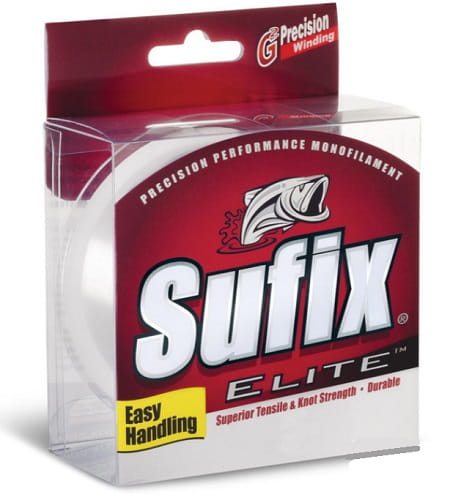
I have a couple of favorites, like the Sufix Elite. The Sufix Elite line is well used and well-liked by river anglers.
I use 10-pound test for most Great Lakes steelhead rivers that are between 20 and 80 feet.
On larger rivers over 100 feet or when fishing for larger steelhead like you would find on the West Coast, a 12 to 16-pound test is best.
Tight Lines!
Graham

))/851238.json)
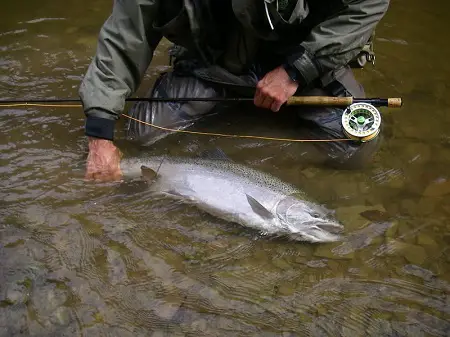
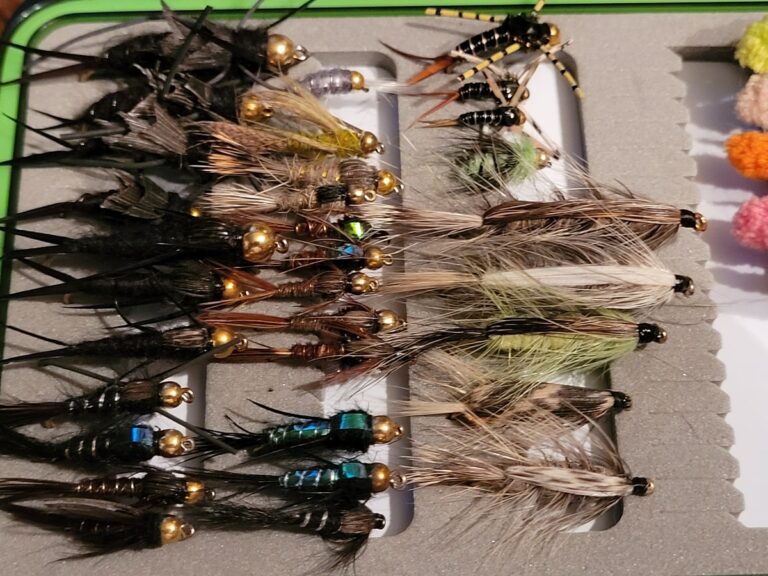
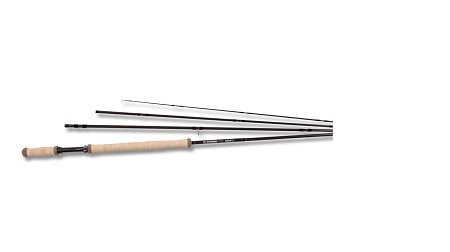
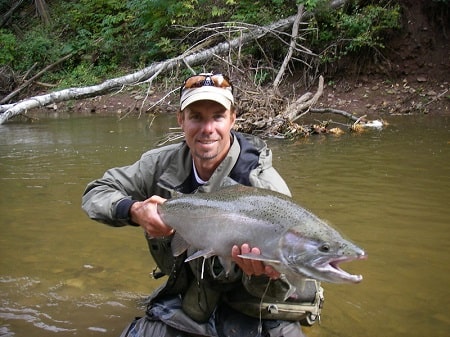
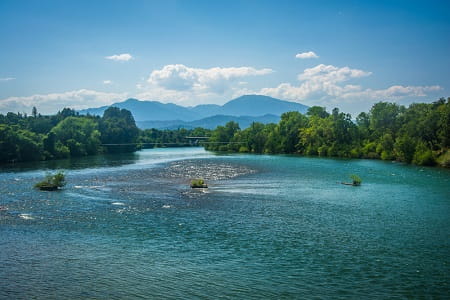
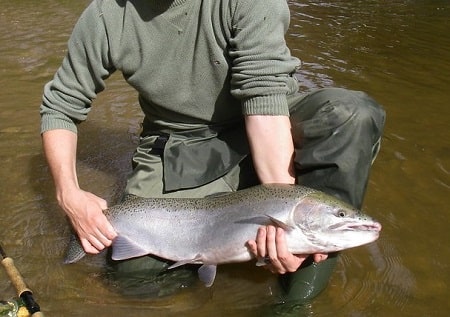
hi…i have trouble with the front hooks tangling with my line when fishing crankbaits. will the lure still be effective if the front hooks are removed?
Ward.
Hi Ward, Yes, the lure should still work as long as the missing hook doesn’t throw off the balance of the lure, which it usually won’t but every lure is different so give it a try and see how it goes. Another option is to remove the front treble hook and add a singe hook there. Good Luck
Try the gold/red Little Cleo 2/5 oz with a single hook for steelhead. Seems to be my favorite colour in the rivers. Readily available and works best in lower light conditions and/or when the water is a bit cloudy.
Thanks for the tip Larry, I will give that color a try and see how it goes. Thats why I say it’s good to rotate through lure sizes and colors until you find something that works for you.
What time of year do I have the best chance at hooking into a steelhead? Also what bait would you recommend for a beginner who knows a good hole and has seen people catch fish out of it but can’t catch one themself?
Hi John, most rivers in your area will have steelhead in them from October to early May. The steelhead enter the rivers in larger numbers after bigger rains which is when the river rises and dirties. It’s best to try and catch them then or try as soon as the river clears and goes green in color. If other people are catching fish and you aren’t, it’s likely your set up and your presentation is the problem, the bait is the last part of the equation. A GOOD BAIT + BAD PRESENTATION = NO FISH. The same is true when lure fishing. It’s best to look up these pages for more tips and best baits for your area. Good luck. 4 Best Steelhead Baits and Float Fishing: Tips From A Pro River Guide For More Trout
My two best baits are #1) a watermelon spin-n-glo, small bead, with a threaded nightcrawler. I generally use a #2 Gamakatsu octopus hook, about 3’6″ to 4’6″ leader, and a slinky weight on a snap swivel above a small bead and barrel swivel. #2) a 1/3 or 2/5 oz Gold Little Cleo with a o-ring and smooth barrel swivel connected to the line so it doesn’t get all spun out and I switch the treble out with a single siwash hook. If it really clear water or very sunny I will sometimes black out half of each side of the spoon with a permanent marker. I’ve caught an awful lot of steelhead on the Rogue and Applegate rivers in Oregon using these two methods.
Hi this is a great site, What is the best time of day? how long do you fish a pool before moving on? FYI i started trout fishing 20 years ago. Hook Line & sinker set me up with a Shimano 9 Ft Rd & spin reel. still have never caught a fish. after reading your site i hope my luck will change. thanks
Thomas
Hi Thomas,
The best time of day can change, during cloudy days sometimes all day is good but on sunny days low light times like mornings and evenings are best, that also depends on water temps, cold water in the morning can make them inactive. I fish a pool for only as long as it takes to cover all of it completely. Sometimes I will use multiple lures in the same pool before I’m ready to move on to the next pool. I hope this website helps you out too. Good luck.
What size single wide gap hook seem to work well when changing out the treble hooks to on say a #4 Vibrax, 2/5 Little Cleo, or 1/2 oz Krocodile?
Good Question George, I usually look at the gap on the treble hook that came with the lure and then change it to a single hook with a gap about 1.5 to 2 times bigger than the gap of the treble. Not the size of the whole treble from one point to the opposite point, just the gap between the center post of the treble and the hook point. For a #4 spinner, I would probably go with a #1 or #2 Raven Specimen hook. Two times the size would be about the same width as the treble is wide. Hope that helps. Good luck
Hi Graham,
Thanks for the fine articles you’ve written which I wish I had found earlier in my fishing journey. I fish for steelhead using homemade spinners and spoons such as Cleos and Thompsons. Thompson spoons are still reasonably priced but the Cleos have become pricey. I do lose a lot of spoons catching them steelies. So to cut cost, I’m making homemade spoons out of my boys’ cracked brass cymbals. They work just as well. Just my contribution to your fine site.
Wes
Hey Wes, Nice to hear from you.. Maybe one day you will turn that into a little business and I will be promoting your spoons on my website. The WesP Spoon company has a nice ring to it. Good luck buddy.
Hi Graham. When using lures, do you still use a heavier main line, and a lighter flurocarbon leader ? Also , what kind of knot do you tie your lures on , with?
Hi Tim, When using lures, the lure is moving fast and the fish is also moving fast so there is a hard impact when the fish grabs the lure. If the fluorocarbon is too light a big steelhead could break you off, therefore, I would use the same size fluorocarbon as your mainline most of the time. The other thing with lure fishing is the fish are not usually line shy because they are so focused on that moving lure.
I could not agree more with your comments regarding spoons. I never really gave them much of a chance, always preferring flashier lures. That was until I was fishing with an elderly mate. He was able to pull several good fish out of pools I swear were empty. He basically cast across, then allowed the current to bounce the spoon across the bottom before it swings up and across. He fished plain white spoons, in the smallest size and weight which can reach the bottom.
I also now use spoons when I suspect the fish are hugging the bottom.
Spoons are something the fish rarely see but they imitate baitfish well and get their attention and they get down to the fish, all a good thing.. thanks for sharing.
I’m in california and want to fish for steelhead. Problem is I’m 16 and broke and the only rod I have is 6’6. It’s got 8 pound fluorocarbon. I want to head to the russian river for some steelhead around January (if that’s not a good time do tell). Do I absolutely need a 9 foot rod or do you think I still have a good chance on mine? I’m planning to use some salmon roe on a trout hook, I’ll have a small splitshot a few inches above, then a bobber, then another small splitshot 5 feet up. I have a few spinners and spoons and if you want me to name em I can. I only have one color of each because they’re so expensive.
Hi Noah,
I’ll be 100% honest with you, that setup will likely leave you empty-handed at the end of the day. If all you have is the 6’6 rod do your best but I highly recommend that if you are going to use bait that you follow my advice and leader set-up. With the combination of your rod and your leader setup, even a guy like me with lots of skill would struggle to catch a steelhead. It’s more about your setup and not the rod that concerns me. Start by reading my page on how to float fish for steelhead.
Gold and Silver are okay. But Copper, copper is the beat. Size 3 aglia is the best only downside is the hooks are too bendy
Thanks for the tips
What size Gmamkatsu Finesse Wide Gap would you use for say replacing the treble hooks on the spoons? And is that just for spoons that tip you gave us or should you replace the trebles on the other lures as well?
Hi Doug,
The size of the hook depends on the size of the spoon. I generally go with a slightly bigger gap (1 and half times bigger) than the gap on the treble hook that comes with the spoon (often that is a size 1 to size 4).
If I use lures like a spoon that I allow to bump or drag the bottom often, I will switch to a single wide gap hook. But with lures like a spinner that I try to keep off the bottom I will leave the treble hook on.
Good Luck,
Graham
The FlatFish is the best selling all-time lure in the world. It was the original type “banana bait” and developed by Charles Helin in the 1930’s. All the others are imitations, which is fine, but the FlatFish was the original wide-wobble banana type bait.
Good info Tom, it’s a great lure that works on many fish. I’ve caught salmon, trout, bass, pike and walleye on the Flatfish and Kwikfish
Best of luck,
Graham
Maribou jigs are my go to deadly
Graham,
Thanks for the great info. I don’t have any experience in catching Steelhead, but I have hooked many smaller rainbows and cutthroat on the rivers where I fish and your advice is similar to how I fish, working the water systematically. However, most of my success is using spinners, (mepps and panther martins).
My question is about the kwikfish/flatfish. I have had some success especially in slower water, but I find them difficult to cast because of how much lighter they are. At least the ones I’m using. So don’t often bother unless the catching is real slow. I may just not have enough experience using them but I find it hard to place them where I want like I can with spinners. I’ve tried adding weight but haven’t found the right amount or where to place it on the line to keep the lures action working.
Any advice you have would be great.
Thanks!
-Joe
US Navy Ret.
Hey Joe,
Spinners are a great lure for searching because they move so fast. Kwickfish/flatfish are a much slower presentation that may work on less aggressive fish so only use them when the spinners arent working, or when you caught all you can on the spinner.
for Kwikfish, I tend to use bigger sizes that are easier to cast, and often smaller trout will grab those bigger sizes too, so upsizing might be a good idea. However, I do agree that lighter lures are a bitch to cast.
If you haven’t already done so, consider using a thinner braided line or a lighter fluorocarbon line. Going as light as a 4-pound test thickness could work since lighter lines tend to cast better and further.
Other than that, it’s just practice casting with the lighter lures.
Hope that helps a bit,
Good luck,
Graham
Hey graham, in terms of spinner size and spoon size, what would be the gran weight do you recommend for lake o tribs as some 3 or 4 size lures will vary on weight
Depends on the current and how far you need to cast. Heavier spinners are good for Faster current, deeper water, and long casts. Slower and shallower water is where lighter and even smaller can excel.